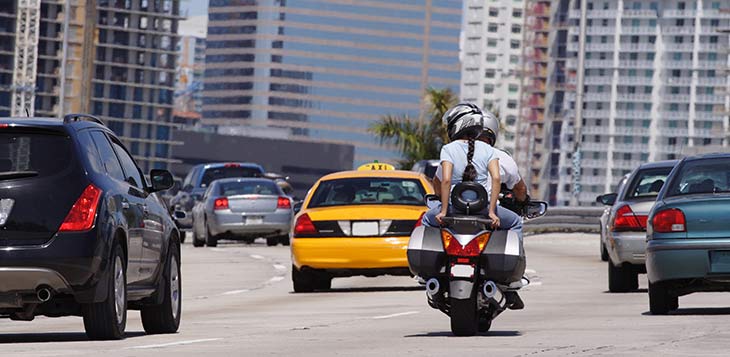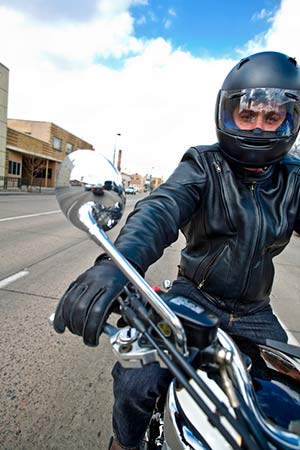victims for over 25 years.
How to Share the Road with Motorcycles
 Top 10 Things Car and Truck Drivers Should Know about Motorcycle Riders
Top 10 Things Car and Truck Drivers Should Know about Motorcycle Riders
The Motorcycle Safety Foundation says that there are four deadly words that are repeated over and over by car and truck drivers who accidentally hit motorcyclists: “I didn’t see him.” Often, that turns into a blame game: “The motorcyclist was in my blind spot.” “He was going too fast.” “He wasn’t obeying traffic laws.” In my experience, many of the motorcyclists I represent know all too well how dangerous it can be to ride Denver’s streets as many car and truck drivers aren’t sure how to safely share the road with motorcycle riders, so they have to take extraordinary measures to be seen.
When you shut down your awareness of them you become blind to riders.
For example, did you know that when you see a motorcyclist swerving from right to left in their lane it’s often because they’re trying to be certain the person in front of them can see them through their rearview and sideview mirrors? Did you know that motorcyclists stop to the right of your back bumper to avoid being crushed between cars if the car behind them doesn’t stop in time?
Ditch Your Stereotypes of Motorcyclists
Yes, we have all seen the motorcycle riders who are clearly playing loose with the law (and with their lives) and it’s easy to stereotype “all riders” based on a few bad bikers. But that mindset could rapidly turn into blindness.

What do I mean by blindness? When you categorize an entire type of people (motorcycle riders) as “idiots” or “reckless,” then you shut down your concern for them. And then you shut down your awareness of them: you become blind to riders. And then bad things happen when you’re still required to share the road with motorcycle riders.
One of my good friends recently decided to buy a motorcycle because her kids are now teenagers and driving themselves around. She wanted a more economical way to get to and from work. This woman is a computer scientist at a large tech company, mother, wife, neighbor, philanthropist, community volunteer, gardener, friend and daughter. Sort of blows up all your stereotypes of “typical motorcycle riders,” right? What if you hit this woman because you aren’t watching for motorcycles on the road?
So, I’d like to share the Motorcycle Safety Foundation’s list of “Ten Things All Car and Truck Drivers Should Know About Motorcycles.”
- Over half of all fatal motorcycle crashes involve another vehicle. Most of the time, the motorist, not the motorcyclist, is at fault. There are a lot more cars and trucks than motorcycles on the road, and some drivers don’t “recognize” a motorcycle – they ignore it (usually unintentionally).
 Because of its small size, a motorcycle can be easily hidden in a car’s blind spots (door/roof pillars) or masked by objects or backgrounds outside a car (bushes, fences, bridges, etc). When you need to share the road with motorcycle riders, take an extra moment to look for motorcycles, whether you’re changing lanes or turning at intersections.
Because of its small size, a motorcycle can be easily hidden in a car’s blind spots (door/roof pillars) or masked by objects or backgrounds outside a car (bushes, fences, bridges, etc). When you need to share the road with motorcycle riders, take an extra moment to look for motorcycles, whether you’re changing lanes or turning at intersections.- Because of its small size, a motorcycle may look farther away than it is. It may also be difficult to judge a motorcycle’s speed. When checking traffic to turn left at an intersection or into (or out of) a driveway, predict a motorcycle is closer than it looks.
- Motorcyclists often slow by downshifting or merely rolling off the throttle, thus not activating the brake light. Allow more following distance, say 3 or 4 seconds. At intersections, predict a motorcyclist may slow down without visual warning.
- Motorcyclists often adjust position within a lane to be seen more easily and to minimize the effects of road debris, passing vehicles, and wind. Understand that motorcyclists adjust lane position for a purpose, not to be reckless or show off or to allow you to share the lane with them. (Always give a motorcyclist the entire lane.)
- Turn signals on a motorcycle usually are not self-canceling, thus some riders (especially beginners) sometimes forget to turn them off after a turn or lane change. Even experienced riders can forget to shut off a signal from time-to-time.
- Maneuverability is one of a motorcycle’s better characteristics, especially at slower speeds and with good road conditions, but don’t expect a motorcyclist to always be able to dodge out of the way.
- Stopping distance for motorcycles is nearly the same as for cars, but slippery pavement makes stopping quickly difficult. Allow more following distance behind a motorcycle because you can’t always stop “on a dime.”
- When a motorcycle is in motion, see more than the motorcycle – see the person under the helmet, who could be your friend, neighbor, or relative.
- If you crash into a motorcyclist, bicyclist, or pedestrian and cause serious injury, your life will also be changed. Could you ever forgive yourself?
A Word About Impatience and Frustration
We are all in such a hurry to get from point A to point B. (We even tailgate and get impatient when we’re looking at Colorado’s fall colors!) How many times in the last month have you hollered out loud in your car because of frustrations on the road? How many times have you pleaded (in your mind or out loud) for the “slow-poke” in front of you to get out of your way (possibly changing lanes to zoom around and cut them off)? How many times have you hit the gas to make a left turn on a yellow or red light, cutting across oncoming traffic?
This impatience and frustration can kill motorcyclists and scooter riders.
I recommend that you watch this video from the Motorcycle Safety Foundation’s website. You’ll probably relate to at least one of the people in the video. (The busy mom hit way too close for home with all of the driving that my busy family does. I recognized her feelings of frustration and distraction.)
The video also brings up another reason that you need to be extra cautious when taking a left turn in front of oncoming traffic: Your passenger is the target that will take a direct hit from oncoming motorcyclists and cars. If you won’t calm down for your own safety or for the safety of other drivers and riders on the road, then at least try to calm down for the safety of the loved ones you’ve got in your own car.
When you’ve seen as many victims of tragic accidents as I have, I can tell you that I look twice every time I signal a change in my driving. And if I’m sitting at an intersection to make a left-hand turn, I never gun it to race through a red or yellow light. It’s just not worth it.
Related Articles:
The Worst Insurance Companies — Learn who The American Bar Association and the attorneys in our office believe are the worst (and best!) insurance companies in Colorado.
— Learn who The American Bar Association and the attorneys in our office believe are the worst (and best!) insurance companies in Colorado.
What Insurance Companies Don’t Want You to Know — You pay them every month but when you need them most, they will make it their mission to pay you as little as possible.
Free Consultation
Search For
Recent Articles
- Careless Driving Incident in Mar Lee Results in Serious Injury
- Possible DUI Involved in Two-Car Collision at W Colfax Ave and I25 HWY SB
- Motorcycle Involved in Traffic Incident on S Downing St, No Serious Injuries Reported
- Motorcycle Accident Reported on I-25 Near Auraria Parkway in Denver
- Motorcycle Accident in Denver Leaves One Seriously Injured
Categories
- Arvada
- Aurora
- Auto Accident eBook
- Auto Insurance
- Bicycle
- Bicycle/Motorcycle Accidents
- Bodily injury
- Car accidents
- Centennial
- Colorado
- Colorado Legislature
- community
- Concussion
- Denver
- Denver Metro Motor Vehicle Accidents
- distracted driving
- DUI Accidents
- Englewood
- Events
- Flood Insurance
- Fort Collins
- Highlands Ranch
- Hit and Run
- In The News
- insurance companies
- Lakewood
- Littleton
- Marijuana DUI
- Motorcycle Accidents
- Motorcycle Insurance
- Motorcycle Law eBook
- Motorcycles
- Newsletter
- Pedestrian
- Personal Injury Law
- Safe Driving
- Safety
- Scooters
- technology
- Thornton
- Tips
- Uncategorized
- vibrio vulnificus bacteria
- Videos
- Westminster
- Winter Driving
Archive
- August 2024
- July 2024
- May 2024
- April 2024
- March 2024
- February 2024
- January 2024
- December 2023
- November 2023
- October 2023
- September 2023
- August 2023
- July 2023
- June 2023
- May 2023
- April 2023
- March 2023
- February 2023
- January 2023
- November 2022
- September 2022
- April 2022
- March 2022
- February 2022
- January 2022
- December 2021
- November 2021
- October 2021
- September 2021
- August 2021
- July 2021
- June 2021
- May 2021
- April 2021
- January 2021
- December 2020
- November 2020
- October 2020
- September 2020
- August 2020
- July 2020
- June 2020
- May 2020
- April 2020
- March 2020
- February 2020
- January 2020
- December 2019
- November 2019
- October 2019
- September 2019
- August 2019
- July 2019
- June 2019
- May 2019
- March 2019
- February 2019
- January 2019
- December 2018
- November 2018
- October 2018
- September 2018
- August 2018
- July 2018
- June 2018
- May 2018
- April 2018
- March 2018
- February 2018
- January 2018
- December 2017
- November 2017
- October 2017
- September 2017
- August 2017
- July 2017
- June 2017
- May 2017
- April 2017
- March 2017
- February 2017
- January 2017
- December 2016
- November 2016
- October 2016
- September 2016
- August 2016
- July 2016
- June 2016
- May 2016
- April 2016
- March 2016
- February 2016
- January 2016
- December 2015
- November 2015
- October 2015
- September 2015
- August 2015
- July 2015
- June 2015
- May 2015
- April 2015
- February 2015
- December 2014
- November 2014
- October 2014
- September 2014
- July 2014
- June 2014
- May 2014
- April 2014
- March 2014
- February 2014
- January 2014
- October 2012
- September 2012
- August 2012
- July 2012
- February 2012
- March 2011
- October 2010